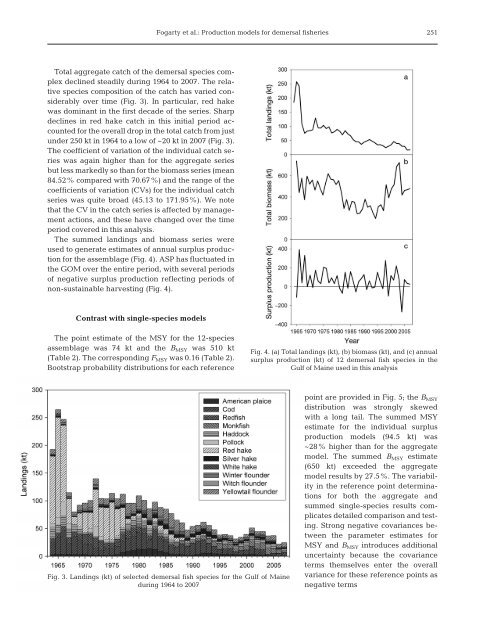Complete Theme Section in pdf format - Inter Research
Complete Theme Section in pdf format - Inter Research
Complete Theme Section in pdf format - Inter Research
You also want an ePaper? Increase the reach of your titles
YUMPU automatically turns print PDFs into web optimized ePapers that Google loves.
Fogarty et al.: Production models for demersal fisheries<br />
251<br />
Total aggregate catch of the demersal species complex<br />
decl<strong>in</strong>ed steadily dur<strong>in</strong>g 1964 to 2007. The relative<br />
species composition of the catch has varied considerably<br />
over time (Fig. 3). In particular, red hake<br />
was dom<strong>in</strong>ant <strong>in</strong> the first decade of the series. Sharp<br />
decl<strong>in</strong>es <strong>in</strong> red hake catch <strong>in</strong> this <strong>in</strong>itial period accounted<br />
for the overall drop <strong>in</strong> the total catch from just<br />
under 250 kt <strong>in</strong> 1964 to a low of ~20 kt <strong>in</strong> 2007 (Fig. 3).<br />
The coefficient of variation of the <strong>in</strong>dividual catch series<br />
was aga<strong>in</strong> higher than for the aggregate series<br />
but less markedly so than for the biomass series (mean<br />
84.52% compared with 70.67%) and the range of the<br />
coefficients of variation (CVs) for the <strong>in</strong>dividual catch<br />
series was quite broad (45.13 to 171.95%). We note<br />
that the CV <strong>in</strong> the catch series is affected by management<br />
actions, and these have changed over the time<br />
period covered <strong>in</strong> this analysis.<br />
The summed land<strong>in</strong>gs and biomass series were<br />
used to generate estimates of annual surplus production<br />
for the assemblage (Fig. 4). ASP has fluctuated <strong>in</strong><br />
the GOM over the entire period, with several periods<br />
of negative surplus production reflect<strong>in</strong>g periods of<br />
non-susta<strong>in</strong>able harvest<strong>in</strong>g (Fig. 4).<br />
Contrast with s<strong>in</strong>gle-species models<br />
The po<strong>in</strong>t estimate of the MSY for the 12-species<br />
as semblage was 74 kt and the B MSY was 510 kt<br />
(Table 2). The correspond<strong>in</strong>g F MSY was 0.16 (Table 2).<br />
Bootstrap probability distributions for each reference<br />
Fig. 4. (a) Total land<strong>in</strong>gs (kt), (b) biomass (kt), and (c) annual<br />
surplus production (kt) of 12 demersal fish species <strong>in</strong> the<br />
Gulf of Ma<strong>in</strong>e used <strong>in</strong> this analysis<br />
Fig. 3. Land<strong>in</strong>gs (kt) of selected demersal fish species for the Gulf of Ma<strong>in</strong>e<br />
dur<strong>in</strong>g 1964 to 2007<br />
po<strong>in</strong>t are provided <strong>in</strong> Fig. 5; the B MSY<br />
distribution was strongly skewed<br />
with a long tail. The summed MSY<br />
esti mate for the <strong>in</strong>dividual surplus<br />
production models (94.5 kt) was<br />
~28% higher than for the aggregate<br />
model. The summed B MSY estimate<br />
(650 kt) exceeded the aggregate<br />
model results by 27.5%. The variability<br />
<strong>in</strong> the re ference po<strong>in</strong>t determ<strong>in</strong>ations<br />
for both the aggregate and<br />
summed s<strong>in</strong>gle-species results complicates<br />
detailed comparison and test<strong>in</strong>g.<br />
Strong negative covariances be -<br />
tween the parameter estimates for<br />
MSY and B MSY <strong>in</strong>troduces additional<br />
uncerta<strong>in</strong>ty because the covariance<br />
terms themselves enter the overall<br />
variance for these reference po<strong>in</strong>ts as<br />
negative terms
















